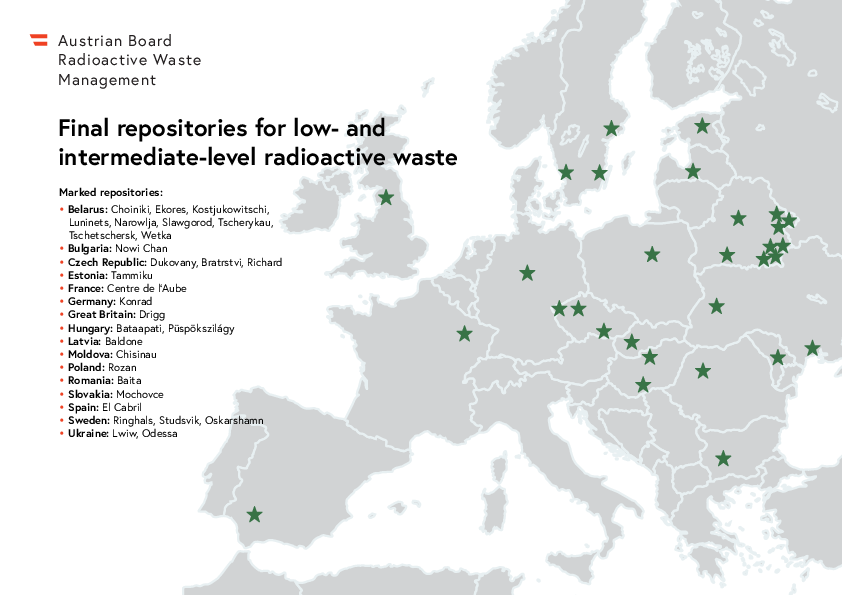Final repository for low- and intermediate-level radioactive waste Some countries have already built a final repository for low- and intermediate-level radioactive waste.
By establishing the Austrian Board for Radioactive Waste Management, Austria has taken the first step in the search for a final repository. Over the next three years, the council will settle important questions regarding the Austrian final repository for low- and intermediate-level radioactive waste.
In some European countries, and notably in several of our neighbouring countries like Germany, the Czech Republic, Slovakia and Hungary, final repositories for low- and intermediate-level radioactive waste have already been built and have commenced operation. They are mostly near-surface repositories or repository mines.
In the Czech Republic the first final repository for low- and intermediate-level radioactive waste was established in the 1950s in Hostim and sealed in 1997. Three Czech final repositories are currently in operation: Richard, Bratrství and Dukovany. Radioactive waste from medicine, industry and research as well as waste containing naturally occurring radionuclides are stored in Richard and Bratrství. The final repository in Dukovany has been designed to house all low- and intermediate-level radioactive waste from the nuclear power plants Temelín and Dukovany until the year 2050.
Germany is currently building a repository for low- and intermediate-level radioactive waste in an old iron mine called “Schacht Konrad” (shaft Konrad). Its operation is slated to start in the late 2020s. Beginning in the 1970s low- and intermediate-level radioactive waste has been stored in the final repositories “Schacht Asse II” (shaft Asse II) and Morsleben. Morsleben no longer accepts any waste and will soon be shut down and sealed off safely. The radioactive waste stored in the shaft system of Asse is currently being retrieved due to stability problems. This waste shall now be stored together with high-level radioactive waste in a future deep geological repository.
Slovakia has been operating the final repository Mochovce for low- and intermediate-level waste since 1999. It is a near-surface repository with concrete troughs. It houses the low- and intermediate-level waste from the nuclear power plants Bohunice and Mochovce.
Hungary started to operate its near-surface final repository Püspökszilágy in 1976. Low- and intermediate-level radioactive waste was disposed of at this facility until 2005, at which point the storage capacity was exhausted. In 2007 the construction of a second final repository in Bátaapáti was started. A few years ago the Hungarian government resolved that the radioactive waste in this repository needed to be retrievable. Since then fixation of the waste in cement has stopped and the facility is now only used as a temporary storage.
The establishment of a final repository for high-level radioactive waste and spent fuel elements constitutes a sizable global challenge. Generally deep geological repositories are viewed as the state-of-the-art storage type that should ensure a safe containment for several hundred thousand years. The first final repository for high-level radioactive waste and spent fuel elements was constructed in Olkiluoto, Finland.
